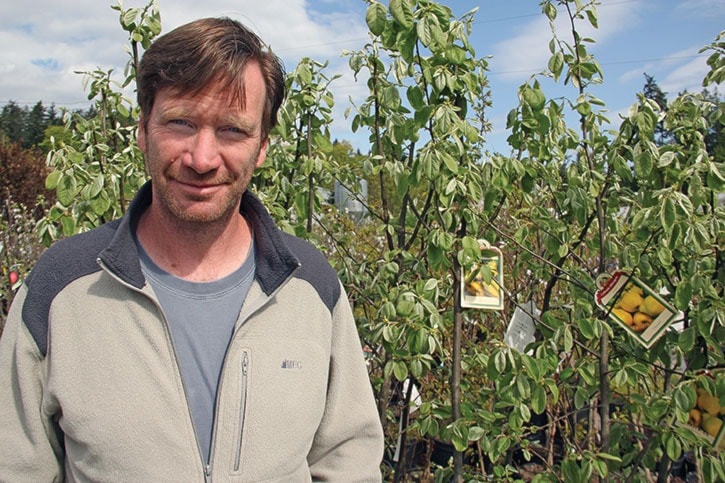When Rob Harris left a career in insurance to oversee 3,000 fruit trees at a Saanich farm, he didn’t anticipate his customers would include so many kids, eager to start edible gardens at home with their parents in tow.
It’s just one trend Harris has noticed in a larger move towards food security in Greater Victoria, as Islanders wake up to the fact that up to 95 per cent of their fresh produce arrives by boat each week.
“My feeling is we are seeing a younger demographic get into gardening via fruits, vegetables and berries,” Harris says. “If people can grow and eat it themselves, they’ll try it. Ornamental isn’t as strong anymore. People want to get something back, and beauty sometimes isn’t enough.”
Harris also gets a lot of professional landscapers who specialize in edible gardens.
“They call it ‘perma-culture’ and it’s big. People are fooding out their yards. Kids are bringing their parents here because they’re concerned about food security.”
New customers are sometimes surprised at the number of fruit trees Harris sells. Fruits like cherry, peach and quince are normally associated with hotter, drier climates like the Okanagan, but Harris said the microclimates of Greater Victoria can present ample opportunity to even grow olives and figs.
“Lemons and limes can grow in a hot, sheltered spot or in a sun room,” he says.
Linda Geggie, who chairs the Capital Region Food and Agriculture Initiatives Roundtable (CR-FAIR), oversees top-level programs that promote food literacy and food security. She agrees younger kids are often learning about the importance of growing local food at school and bringing that education home to parents. One such program is the Connecting for Healthy Food in Schools Network, which CR-FAIR helps co-ordinate.
“It’s interesting to see there’s a breadth and depth of food literacy happening in schools, everything from the school having a food garden to farm-to-school activities like salad bars coming from local farms or edible school yards. You just see things growing,” Geggie says.
Geggie notes the parallel to early recycling education programs that ran in schools before large-scale Blue Box recycling became the norm.
A July 2014 survey conducted by the Vancouver Foundation and the Real Estate Foundation of B.C. revealed about 80 per cent of the 1,700 B.C. residents interviewed said they were concerned about dependence on other countries for food security. When asked what priority uses for land were, respondents identified “natural freshwater systems” (83 per cent), closely followed by “farming and growing food” (81 per cent). Geggie sees these numbers as reflective of a trend, and one of CR-FAIR’s big initiatives is working with municipalities to identify public land that can be used to produce food locally.
“Part of what we’re doing is asking if we were going to increase our local food production from five per cent to even 25 per cent, what would it take,” she says.
Part of that solution involves home gardeners.
“This is about people being concerned about food. They want to find ways that they individually can make a difference. CR-FAIR is working with the big organizations, but we also need individuals to step up and do their part,” Geggie says.
Harris is planning for a busy spring, as homeowners take advantage of even small patio spaces to grow plants, flowers and food.
“There’s deer-resistent stuff, bird- and bee-friendly stuff, people are interested in doing something for the environment, and they’re concerned with their food and where it comes from. It’s great to see.”
DID YOU KNOW?
In February of 2014, Saanich council passed a motion to have staff explore partnerships and options for the creation of a farmland trust. The goal is to ensure the protection of farmland as areas for food production in the future.
On May 25 at 7 p.m., CR-FAIR, the District of Saanich and other partners will host a farmland access community forum at Saanich Commonwealth Place.
Top 10 ways to change the food system:
1. Drink tap water.
2. Eat at home more often instead of eating out: Children consume almost twice (1.8 times) as many calories when eating out.
3. Grow your own food: Keep a garden – even a small one – so you can enjoy a direct connection to food. Save seeds, partner with neighbours or find land through the sharingbackyards.com program.
4. Work with schools to increase healthy food options and to abide by Healthy Vending regulations to stop selling sodas, junk food and sports drinks.
5. Meatless Monday: Go without meat one day a week because it requires a higher amount of energy to produce, especially beef.
6. Buy organic or sustainable food that is likely to be exposed to strong pesticides. (Google Shopper’s Guide to Pesticides )
7. Support family farms by visiting your local farmer’s market – check out a list of local farmers at islandfarmfresh.com
8. Read Labels. Make a point to know where your food comes from and what is in it.
9. Demand job protections for farm workers and food processors, and support fair trade.
10. Become engaged in projects that support developing a healthier and sustainable food system. Find out more at crfair.ca.
